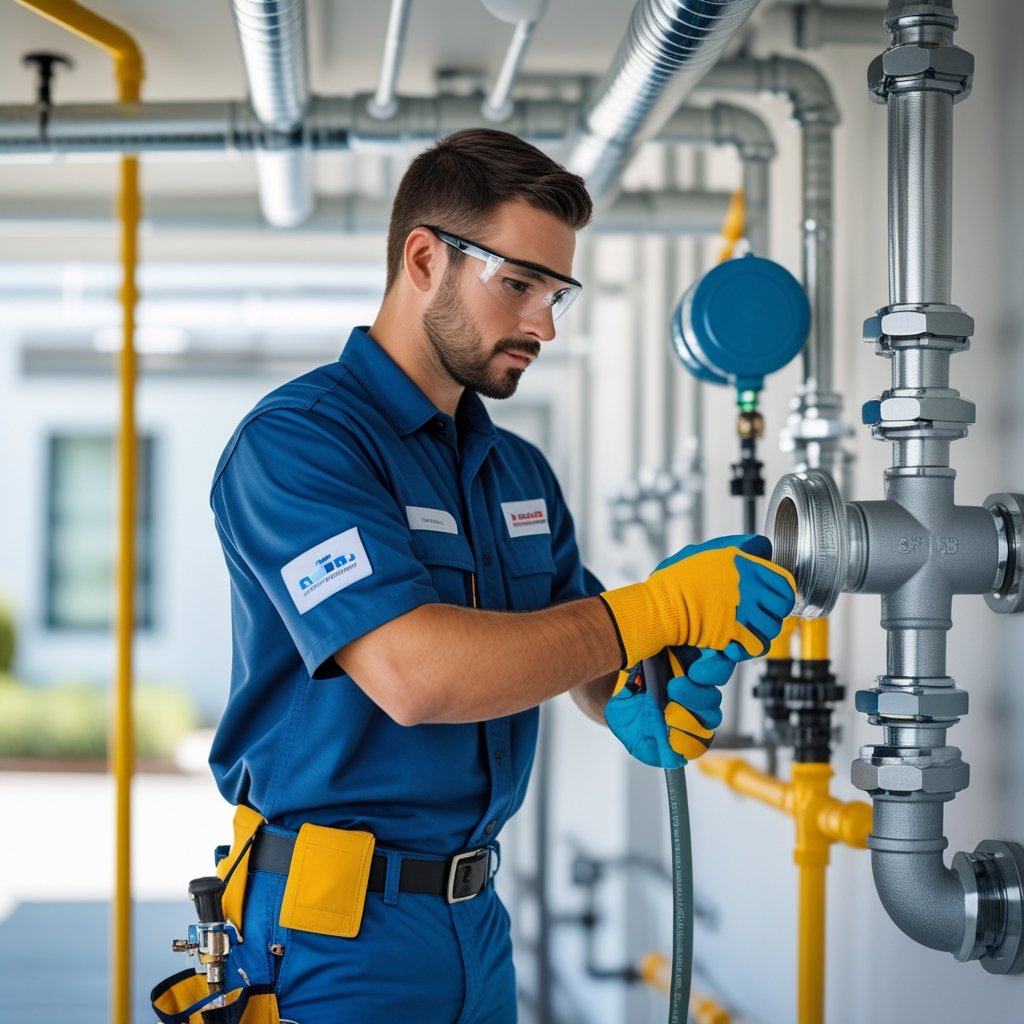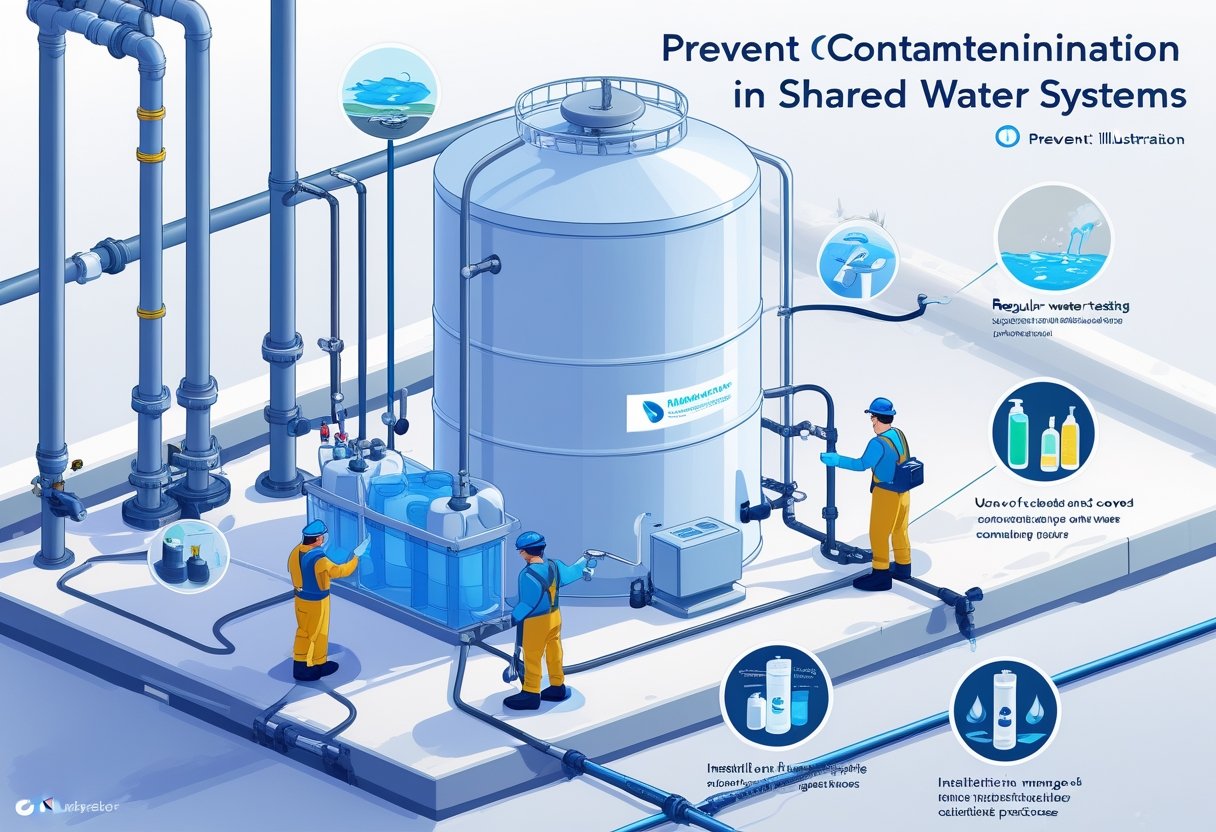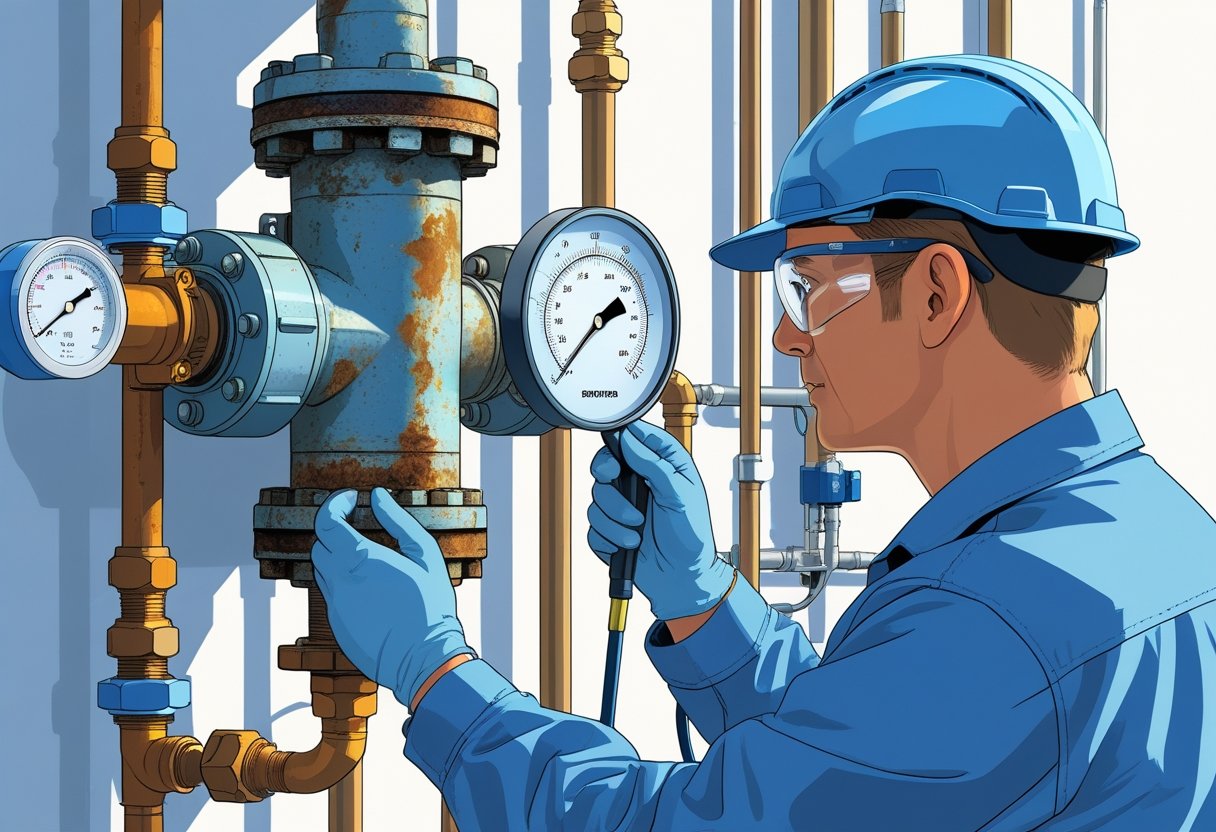Managing backflow compliance is a key part of keeping your property’s water supply safe and meeting local laws. A clear backflow compliance checklist helps you stay organized and ensures your system is tested, maintained, and repaired on time. This protects you from fines and prevents contamination of your water system.
Your responsibilities include scheduling annual backflow testing with certified technicians, keeping detailed records for at least three years, and addressing any repairs quickly. Pacific Backflow offers reliable, fast testing and handles paperwork for you, making compliance easier across San Diego County. Following a simple checklist can help you avoid mistakes and keep your property in good standing with water authorities.
Understanding Backflow Compliance
Backflow compliance keeps your property’s water supply safe and satisfies legal requirements. You’ll need to know what backflow is, how the law treats it, and what can happen if you don’t keep up with maintenance and testing.
What Is Backflow and Why Does It Matter?
Backflow is when water flows backward into your clean water system. That can pull in nasty stuff—chemicals, bacteria, you name it—right into your drinking water.
A backflow preventer blocks this from happening. It keeps dirty water away from your clean pipes. Without it, you’re risking contamination for anything you use water for—drinking, cooking, cleaning.
If your backflow preventer isn’t working, that’s a real threat to health and safety. Annual testing checks if it’s doing its job. Fail the test? You’ll need repairs or a replacement, fast, to keep your water safe.
Legal Requirements for Property Managers
As a property manager, you’re on the hook for backflow prevention. Laws in San Diego County (and pretty much everywhere else) require you to test and maintain backflow devices regularly.
You have to schedule annual tests with certified professionals. Testing results need to be documented and sent to local water authorities.
If you skip these steps, you could get fined or even lose water service. Keep paperwork up to date, schedule repairs when needed, and make sure your backflow system is up to code. Local codes aren’t optional.
Risks of Non-Compliance
Ignoring backflow compliance isn’t just risky—it can be downright disastrous. The most immediate danger? Contaminated water that can make residents, tenants, or customers sick.
Non-compliance might lead to:
- Financial penalties from authorities
- Water shutoffs until you fix the problem
- Legal trouble if someone gets sick
Stick with proper maintenance and use a dependable service like Pacific Backflow. It’s just not worth the risk.
Key Elements of a Backflow Compliance Checklist
To keep your property’s water safe and meet all regulations, you need to focus on the right devices, proper documentation, and clear identification. These parts help you stay organized and ready for inspections.
Inventory of Backflow Prevention Devices
Start by listing every backflow prevention device on your property. Note the device type, model, age, and when it was installed. This way, you can keep track of each one and know when it’s time for maintenance or replacement.
Update your inventory whenever you add or remove a device. Having this list helps you comply with annual checks and makes scheduling tests and repairs less of a headache.
Documentation and Recordkeeping
Hang onto detailed records for all backflow testing, repairs, and maintenance. Include the tester’s name, test results, what repairs were done, and service dates. You’ll need to keep these for at least three years—most water districts require it.
Keep these docs organized (digital or paper, your call). If your device fails a test, you’ll want repair records handy to show you acted fast. Water authorities might ask for proof, so don’t skip this step.
Device Identification and Location
Every backflow preventer should be easy to spot. Label each one with a unique ID that matches your inventory. Note where it is—building area, pipe connection, whatever makes sense.
This makes inspections faster and prevents tampering or accidental damage. If you think it’s necessary, use secure covers or cages for extra protection.
Pacific Backflow can help you set up and maintain this checklist, so you’re always ready for an inspection in San Diego County.
Inspection and Testing Procedures
To keep your property’s water supply safe, you’ll need a clear process for inspecting and testing backflow prevention devices. Regular checks spot issues early, and annual tests confirm everything’s working as it should. Working with certified testers makes life a lot easier.
Routine Inspection Steps
Start with a simple visual check. Look for leaks, cracks, or anything that seems off. Check valve seals and relief valves for wear or discharge.
If your device is outside, protect it from the weather—insulation or heat tape for cold, maybe a cover. Keep the area clear of debris.
Do these quick checks a few times a year, between formal tests. It’s a good way to avoid surprise failures and expensive repairs.
Annual Testing Requirements
Most water authorities want you to test backflow preventers every year. Certified testers handle the job and make sure it’s up to code.
During the test, the technician checks internal valves to see if they hold up against backpressure and block contamination. If it fails, fix or replace it right away.
Keep records of every inspection, test, and repair for three years. In some places, you’ll need to send test reports to the water agency. This paperwork proves you’re following the rules.
Working With Certified Testers
Always hire certified testers for inspections and annual tests. They’ve got the training and tools to spot problems you might miss.
Good testers can save you money by catching issues early. They’ll also handle submitting reports to the city, so you can skip the paperwork hassle.
Pacific Backflow covers San Diego County with quick, reliable testing. Their certified techs keep you compliant and take the stress off your plate.
Corrective Actions and Ongoing Maintenance
To keep your backflow system working, you’ve got to fix problems fast and stick to regular checkups. That’s how you protect your water supply and stay on the right side of local laws.
Addressing Failed Inspections
If your backflow device fails an inspection, take care of it right away. Call a licensed professional for repairs. Typical problems are worn parts, leaks, or debris.
After repairs, get the system retested to make sure it’s fixed. Keep all the paperwork—your water authority might ask for proof.
Acting fast helps you avoid fines or water shutoffs. Pacific Backflow can handle repairs and retesting, so you’re back in compliance quickly.
Scheduling Regular Maintenance
Most codes require annual testing and maintenance. Mark your calendar so you don’t forget.
Regular checks catch small problems before they turn into big ones. Keep a maintenance log with all test results and repairs. If regulators have questions, you’ll have answers.
Set reminders or work with a dependable backflow service. It’s less hassle, and you’ll stay ahead of trouble.
Managing Backflow Compliance Across Multiple Properties
If you manage several properties, organization is everything. You’ll need consistent rules for inspections and repairs, plus a team that knows what’s what.
Creating Consistent Procedures
Make a clear schedule for yearly backflow tests at every property. Use a master calendar to track test dates and repairs. Stick to the same process for inspections, fixes, and paperwork everywhere.
Document each test and repair. If water authorities come calling, you’ll have proof. A simple checklist helps everyone follow the right steps.
Your process might look like:
- Confirm test dates with certified technicians
- Review test results within 48 hours
- Schedule repairs ASAP if a device fails
- File reports by the deadline
Consistency lowers your risk of fines and keeps your water supply safe.
Training Staff and Contractors
Everyone involved should know the backflow rules and your procedures. Train your building managers, maintenance crew, and contractors.
Teach them how to spot problems, who to call for tests, and what to do in an emergency. Written guides and checklists make things stick.
Only use certified testers for inspections and repairs. Pacific Backflow has skilled techs who know the local rules, making your life easier.
Regular training keeps your team sharp and helps prevent missed tests or late repairs. That way, you stay compliant without the headache.
Records Submission and Reporting
Accurate records and timely reporting are essential for backflow compliance. You need to know when and where to send reports, and stay aware of any rule changes.
Submitting Reports to Authorities
You’ve got to send backflow test results to your local water authority. Usually, that means sending test forms within 30 days of testing. These reports show your backflow preventers are working.
Some water districts want online submissions, others accept mail or fax. Double-check requirements so you don’t miss deadlines. Always keep copies for your records.
If you had to make repairs, send in repair certificates as proof. Missed or late reports can mean fines or even losing water service.
Staying Up to Date With Compliance Changes
Backflow rules change—new standards, new policies, you name it. Stay in the loop by checking your water district’s updates.
Sign up for email alerts or newsletters to catch changes in testing schedules, forms, or reporting procedures. Your backflow service provider, like Pacific Backflow, can also give you a heads-up about compliance changes.
Review these updates regularly so you don’t get blindsided. It’ll help you plan ahead and avoid penalties.
Tips for Simplifying Backflow Compliance
Dealing with backflow compliance can feel like a headache, honestly. One of the best moves? Schedule annual tests early. That way, you dodge the last-minute scramble and those annoying deadline surprises.
Find a trusted service provider—Pacific Backflow's a good example. Their certified techs handle the testing, fix problems, and even sort out the paperwork. They’ll submit reports straight to the city, so you don’t get stuck chasing forms or emails.
Staying organized helps more than you’d think. Just keep a simple log of every test, repair, and inspection. Jot down stuff like:
ItemDetails to Record Test DateWhen the backflow device was testedTester NameWho performed the testingResultsPass or failRepairs NeededAny fixes made or scheduled
Don’t forget to check local rules for your area—especially around San Diego County. Requirements shift from place to place, so give your water authority or AHJ a call if you’re not sure what’s current.
Backflow devices can get damaged or messed with, sometimes by accident, sometimes not. Using a cage or cover can save you a lot of hassle (and money) down the line.
If a test fails, act fast. Fix or swap out the device right away—delaying just leads to bigger headaches. Pacific Backflow can usually get repairs or emergency calls handled quickly, which honestly is a relief.
Frequently Asked Questions
Backflow compliance means regular testing, keeping records, and handling problems as soon as they pop up. You’ll want to know who’s allowed to do the tests and what to do if something goes wrong—your property (and everyone in it) depends on it.
What are the essential steps for a property manager to ensure backflow prevention device compliance?
Book annual tests with a certified pro. Make sure devices stay in good shape, and fix or replace anything that fails. Stay on top of local rules and keep up with the paperwork.
How frequently should backflow prevention devices be tested and who is qualified to perform these tests?
You need to test backflow devices every year. Only certified testers can legally do these checks, so don’t cut corners—local water authorities are pretty strict about that.
Can you provide a checklist to help maintain compliance with local backflow preventer regulations?
- Book yearly tests with a certified professional
- Check devices now and then for damage or wear
- Repair or swap out anything that fails, quickly
- Keep all reports and records in one place
- Watch for updates from your local water district
What documentation do I need to keep on file for backflow compliance, and for how long should it be retained?
Hang on to all your test reports, repair invoices, and maintenance records. Usually, you need to keep them for at least three years—but it never hurts to double-check your local rules.
In case of a backflow incident, what immediate actions should a property manager take to safeguard the residents?
Cut off the water supply right away to stop contamination. Call a certified backflow service for emergency repair. Let residents know if needed, and write down everything you do.
What are the penalties for non-compliance with backflow prevention regulations?
You might get hit with fines, citations, or even some legal trouble. If you skip testing or forget to fix devices when needed, the water authority could come after you for health and safety violations. Not exactly something anyone wants to deal with, right?











